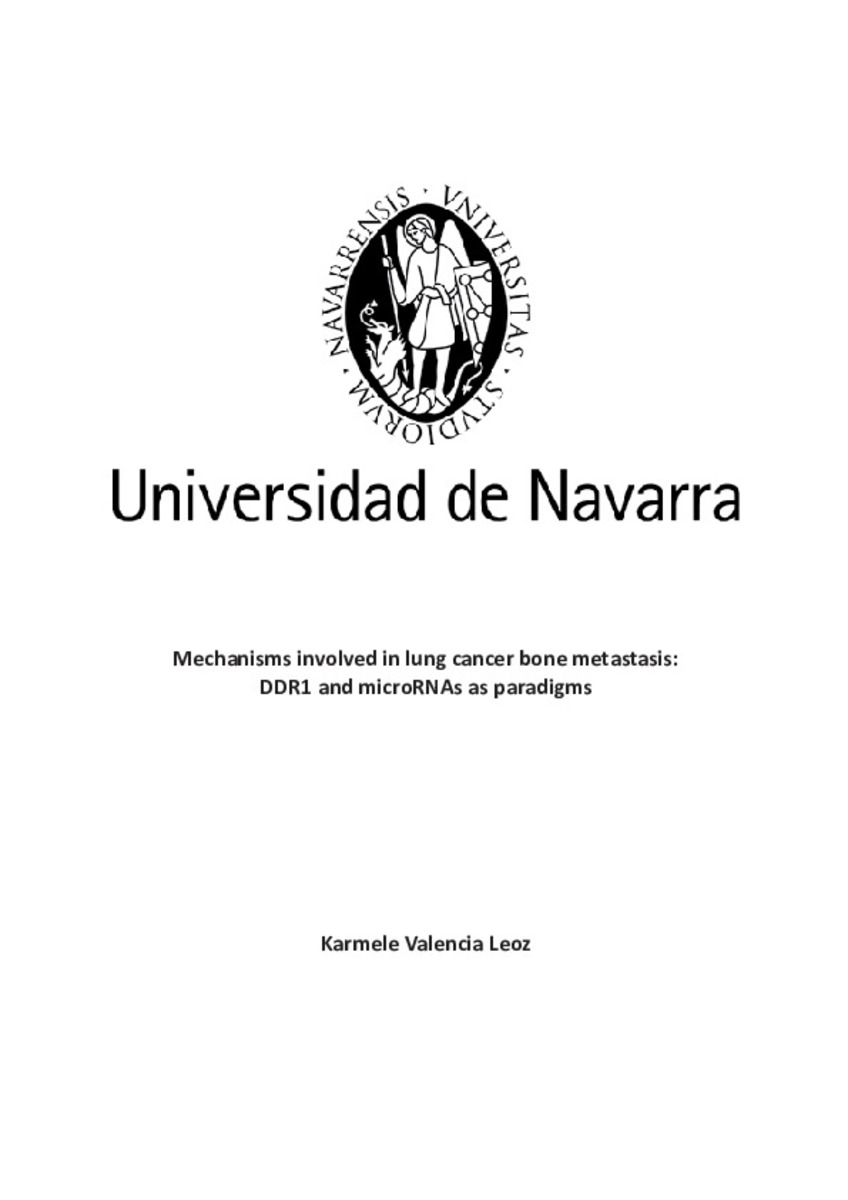Full metadata record
| DC Field | Value | Language |
|---|---|---|
| dc.contributor.advisor | Lecanda, F. (Fernando) | - |
| dc.contributor.advisor | Bandres, E. (Eva) | - |
| dc.creator | Valencia, K. (Karmele) | - |
| dc.date.accessioned | 2013-03-15T12:00:41Z | - |
| dc.date.available | 2013-03-15T12:00:41Z | - |
| dc.date.issued | 2013-03-15 | - |
| dc.date.submitted | 2012-09-26 | - |
| dc.identifier.citation | VALENCIA LEOZ, Karmele. “Mechanisms involved in lung cancer bone metastasis:DDR1 and microRNAs as paradigms”. Lecanda, Fernando; Bandrés, Eva Tesis doctoral. Universidad de Navarra, Pamplona, 2012 | es_ES |
| dc.identifier.uri | https://hdl.handle.net/10171/28133 | - |
| dc.description.abstract | Bone metastasis represents one of the most devastating consequences of lung cancer associated with poor prognosis. Given the relevance of cell-matrix interactions and the regulatory mechanisms of large multigenic networks implicated in metastasis, we studied the tyrosine kinase DDR1 and miRNAs as two paradigms involved in this process. DDR1 is a collagen receptor found in highly invasive tumor cells. Interestingly, high levels of DDR1 were associated with a decrease survival in stage I lung cancer patients patients. Using a model of lung cancer bone metastasis we demonstrated that abrogation of DDR1 levels led to stunted decrease in metastatic activity mediated by impaired homing and colonization. These effects were associated with a decreased tumor cell survival and decreased invasive and osteoclastic activities. Thus, DDR1 represents a therapeutic target involved in bone metastasis. Using the same model, we unveiled the relevance of a novel mechanism of metastatic colonization consisting in the tumor release and transfer of miR-192 within CD63+ enriched exosomes to the endothelial compartment of the osseous milieu. Exosome fusion to endothelial cells was accompanied by the repression of key proangiogenic chemokines. These findings were associated with a functional impairment of the tumor-induced angiogenic program. miR-192 governs non-cell autonomous functions that globally impair metastatic bone colonization. Interestingly, serum levels of miRNAs were asssociated with osseous colonization. Thus, these two paradigms reveal novel mechanistic insights and identify a new window of opportunity for innovative strategies of thereputic intervention. | es_ES |
| dc.language.iso | eng | es_ES |
| dc.publisher | Universidad de Navarra | es_ES |
| dc.rights | info:eu-repo/semantics/openAccess | es_ES |
| dc.subject | Materias Investigacion::Ciencias de la Salud::Genética | es_ES |
| dc.subject | Biología celular | es_ES |
| dc.title | Mechanisms involved in lung cancer bone metastasis:DDR1 and microRNAs as paradigms | es_ES |
| dc.type | info:eu-repo/semantics/doctoralThesis | es_ES |
Files in This Item:
Statistics and impact
Items in Dadun are protected by copyright, with all rights reserved, unless otherwise indicated.






